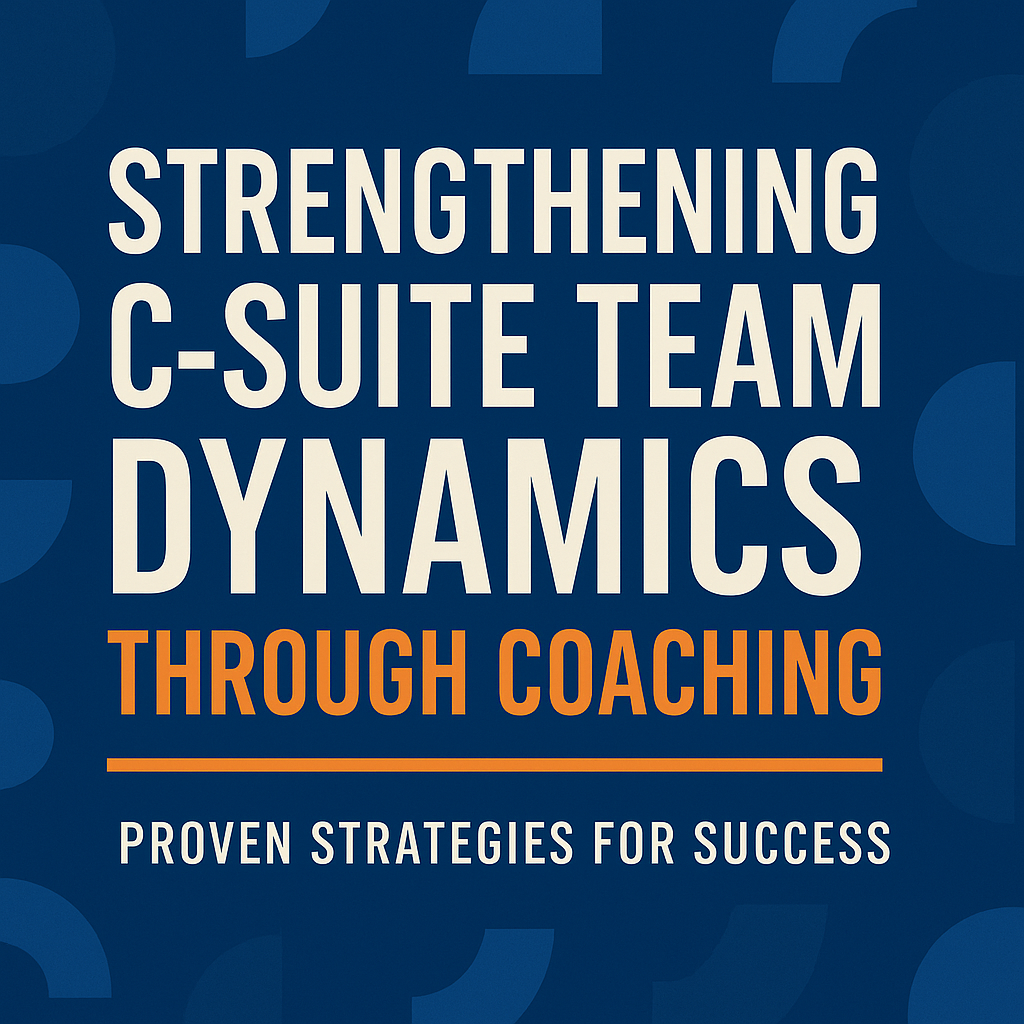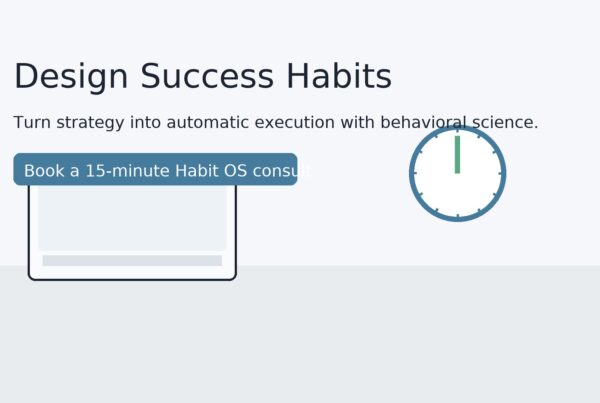Strengthening C-Suite Team Dynamics Through Coaching: Proven Strategies for Success
Strengthening C-suite team dynamics through coaching enhances trust, communication, and executive collaboration. This article explores strategies to create a more cohesive and effective leadership team.
Want to build stronger, more aligned C-suite leadership? Let’s explore how tailored coaching can unlock your team’s potential. Book a quick strategy call.
Key Takeaways
- Strong interpersonal relationships and clear communication are essential for effective C-suite team dynamics, driving innovation and performance.
- Executive coaching enhances emotional intelligence and tailored leadership skills, fostering a collaborative and high-performing executive team.
- Continuous learning and personalized coaching are vital for leaders to adapt to challenges and maintain a culture of innovation within organizations.
Understanding C-Suite Team Dynamics

Effective team dynamics among C-suite leaders are the backbone of organizational success. When executives collaborate seamlessly and are on the same page, they foster an environment where innovation thrives, and decision-making is enhanced. Imagine a scenario where every executive brings their unique perspective to the table, enriching discussions and driving creativity. Healthy team dynamics transform challenges into opportunities for growth and innovation, contributing to effective team development.
Building strong interpersonal relationships among C-suite members is vital. When trust and mutual respect are established, the entire team benefits from a unified approach that boosts creativity and execution. Moreover, fostering a culture of psychological safety and a safe space encourages open communication, allowing executives to voice their ideas and concerns without fear of retribution. This environment not only enhances team performance but also prevents misunderstandings and misalignments.
However, poor dynamics can lead to significant issues. Misunderstandings, reduced morale, and hindered performance are just a few of the repercussions. Clear and concise communication is essential to keep teams aligned towards their goals. Emphasizing diverse perspectives within the team enriches decision-making and fuels innovation. Reinforcing the benefits of better performance through productive conflict outcomes helps sustain a culture of open dialogue and continuous improvement.
If your executive team isn’t firing on all cylinders, it’s time for a breakthrough. Book your complimentary 15-minute call now.
The Role of Executive Coaching in Enhancing Team Dynamics

Executive coaching is a powerful tool for enhancing team dynamics within executive teams. Its primary focus is building strong teams and developing talent, ensuring every leader can contribute effectively to the organization’s success. Effective leadership coaching enhances leaders’ ability to implement new knowledge. This, in turn, improves team dynamics, decision-making, and workplace culture. Leaders who balance logical reasoning with empathy can unlock higher levels of engagement and performance among their teams. An executive coach can further facilitate this process.
Emotional intelligence is a critical skill that executive coaches emphasize. It enables leaders to manage their emotions and understand others’ feelings, fostering better teamwork. Coaching helps create environments where team members feel heard, valued, and empowered, leading to a more collaborative and productive team. Leadership coaching is most effective when it addresses the skills required during feedback, conflict resolution, and decision-making processes.
Tailored coaching approaches are essential for enhancing team dynamics. By focusing on individual strengths and team dynamics, coaches can provide personalized guidance that addresses the unique needs of each executive and the entire team. Digital coaching tools also provide on-demand insights, supporting leaders in leading their teams more effectively through team coaching.
Coaching is no longer a luxury for high performers — it’s a necessity. Ready to see what’s possible? Let’s talk.
Key Interpersonal Skills for C-Suite Leaders
Mastering key interpersonal skills is crucial for C-suite leaders to foster a collaborative and high-performing team. Emotional intelligence allows leaders to connect with their team members personally, creating a work environment where everyone feels valued and understood. This connection is the foundation of effective leadership and contributes to a supportive organizational culture.
Active listening is another critical skill for C-suite leaders. By fully comprehending team members’ inputs, leaders can create a more engaged and cohesive work environment that fosters employee engagement. Active listening shows that leaders value their team members’ contributions and helps identify potential issues before they escalate. Building strong relationships among team members enhances collaboration and promotes a culture of mutual support and respect.
Developing these skills requires more than intention—it requires guided action. Click here to schedule your personal consultation.
Effective conflict resolution techniques are essential for maintaining harmony within the leadership team. By demonstrating these techniques, leaders set a standard for team interactions and reduce misunderstandings. This proactive approach to conflict resolution ensures that issues are addressed constructively, leading to stronger solutions and greater organizational resilience.
Communication Styles and Their Impact on Team Performance
Mastering communication styles among C-suite members is fundamental to the executive team’s overall effectiveness and harmony. Self-awareness, a component of emotional intelligence, helps leaders remain composed under pressure, which is essential for effective decision-making. When leaders manage their emotions well, they set a positive example for the rest of the team, contributing to a stable and focused work environment.
Empathy plays a significant role in leadership, allowing leaders to connect with their teams and respond to their needs more effectively. Understanding and addressing team members’ emotional and professional needs fosters a sense of belonging and loyalty. Effective communication is crucial, as studies show that nearly half of respondents experience decreased productivity due to poor communication. By adopting a compelling communication style, leaders can ensure that their messages are clear, concise, and impactful, leading to a deeper understanding of better team performance and engagement, and how to lead effectively. This approach ultimately leads to stronger relationships within the team.
Adapting communication skills to suit individual strengths and situations is essential for achieving optimal outcomes. Leaders who can flex their communication approach based on their team members’ context and needs can facilitate better collaboration and decision-making. This adaptability is a skill and a strategy that can significantly enhance team dynamics and performance.
Communication issues cost productivity. Fixing them starts at the top. Book a call to discuss your team’s communication strengths and gaps.
Conflict Resolution Strategies for High-Performing Teams

Conflict within executive teams is inevitable, but it can lead to stronger solutions and greater resilience when managed constructively. Transformational leaders enhance team performance through effective conflict management, turning potential disruptions into opportunities for growth. Understanding one’s leadership style is crucial for managing conflicts effectively. Leaders must be aware of how their approach can either escalate or de-escalate tensions within the team.
Leaders spend nearly a quarter of their time addressing conflicts. Different communication styles, such as coaching and advising, can be employed based on the context to foster better team decision-making skills. Empowering employees to resolve conflicts independently can help identify areas that prevent unnecessary complications and foster a sense of ownership and responsibility among team members, enabling them to make informed choices. Understanding various leadership styles can further enhance this process of making decisions.
Introducing a ‘devil’s advocate’ in team discussions can stimulate healthy debate and challenge team ideas, leading to more robust and well-rounded decisions. Clear goals and a shared vision are essential for effective conflict resolution. When team members are aligned on the strategic objectives, it becomes easier to navigate conflicts and maintain focus on the organization’s same goal. This alignment ensures that conflicts are resolved in a manner that supports the team’s overall mission and enhances performance.
What if conflict became your team’s greatest strength? Discover how with a short call. Schedule here.
Building Trust and Collaboration Through Coaching Sessions

Building trust and collaboration within executive teams is a process that can be significantly enhanced through coaching sessions. Emphasizing accountability within the team fosters trust and focuses efforts on task completion rather than blame. Consistency in delivering on promises is essential for proving reliability and reinforcing trust among C-suite executives. When leaders are consistent and transparent, it builds confidence and sets a standard for the rest of the team, helping to build resilience.
Adapting communication styles to suit team members’ needs and situations is crucial for achieving optimal outcomes in team performance. Clear and transparent communication helps to illustrate the advantages of proposed changes, aiding in trust-building. Establishing psychological safety encourages team members to voice differing opinions without fear, which fosters better communication, innovation, and collaboration.
Tailoring one-on-one coaching approaches to individual executive needs can significantly enhance the effectiveness of building rapport and trust. By focusing on each leader’s unique strengths and development areas, coaches can create a more personalized and impactful coaching session experience. This tailored approach builds trust and drives the entire team towards greater collaboration and success.
Real-Life Examples of Successful C-Suite Coaching

Real-life examples of successful executive coaching initiatives illustrate the tangible benefits of investing in leadership development. One notable example is an executive coaching initiative that guided a turbulent executive team through transition, fostering trust and collaboration. This coaching effort led to a thriving organizational culture as the executive team overcame challenges and improved its functioning. The transformation of team dynamics through coaching is a testament to its effectiveness in enhancing collaboration and trust.
The success of such cases highlights the value of executive coaching for C-suite leaders. By investing in a coach, organizations can drive significant improvements in team dynamics, leading to greater organizational and C-suite success. These real-life examples are powerful reminders of the impact that coaching can have on leadership teams and their overall performance.
Want your executive team to be the next success story? Let’s start the conversation.
Continuous Learning and Development Opportunities
Continuous learning enhances leadership capabilities and prepares leaders for future challenges. In today’s business environment, staying relevant requires ongoing professional development. Continuous learning equips leaders to innovate and foster creativity, ensuring they can effectively navigate the complexities of the modern workplace.
Ongoing professional development encourages leaders to innovate and foster creativity. Continuous coaching drives retention and real behaviour change, helping leaders continuously improve and adapt to new challenges. Effective leadership coaching is personalized, contextual, team-centred, and continuous, developing leaders with the tools they need to succeed.
By investing in continuous learning and development opportunities, organizations can ensure that their leaders are well-prepared to face future challenges and achieve their organizational goals. This investment drives long-term success and fosters a culture of new ideas, innovation, and growth within the organization.
Summary
Strong team dynamics within the C-suite are crucial for organizational success. Effective executive coaching can enhance these dynamics by improving interpersonal relationships, communication, conflict resolution, and continuous learning. By investing in coaching, organizations can cultivate high-performing leadership teams that thrive on collaboration and trust.
Strengthening C-suite team dynamics is an ongoing process, but the rewards are well worth the effort. Organizations can drive significant improvements in team performance and overall success by focusing on developing key interpersonal skills, adapting communication styles, and fostering a culture of continuous learning.
Your leadership team’s potential is too valuable to leave to chance. Book your 15-minute call now. Let’s explore what’s next — together.
Frequently Asked Questions
What are the benefits of executive coaching for C-suite leaders?
Executive coaching empowers C-suite leaders to elevate team dynamics, sharpen decision-making, and foster collaboration. Enhancing leadership skills and emotional intelligence paves the way for more effective and inspiring leadership.
How can executive coaching improve team performance?
Executive coaching can significantly boost team performance by building trust, enhancing communication, and resolving conflicts effectively. Aligning individual strengths with team dynamics creates a more cohesive and high-performing team environment.
What interpersonal skills are essential for C-suite leaders?
Emotional intelligence, active listening, and effective conflict resolution are essential interpersonal skills for C-suite leaders. These skills cultivate strong relationships and promote a collaborative culture. Mastering these skills will empower you to lead with impact and inspire your team!
How does continuous learning benefit C-suite leaders?
Continuous learning empowers C-suite leaders to remain relevant and drive innovation in a rapidly changing business landscape. They can effectively tackle future challenges and inspire their teams by embracing new knowledge and skills.
What role do communication styles play in team dynamics?
Communication styles are crucial for effective team dynamics, shaping how information flows and team members interact. Embracing diverse communication strategies can significantly boost collaboration and decision-making, leading to a more successful team environment.



